|
Geneva Motor Show 2012: Suzuki unveils
low emissions G70 concept car
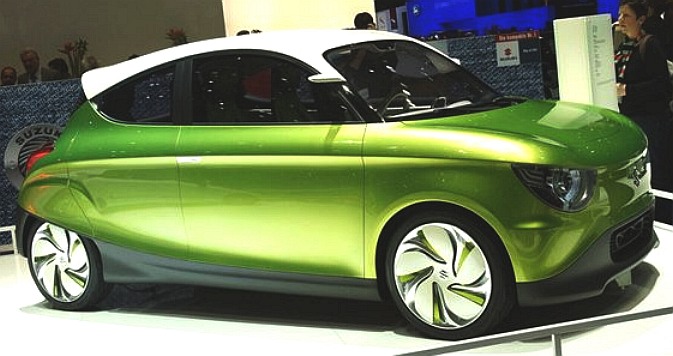
Geneva motor show, Suzuki eco G70 concept car
Suzuki Motor Corporation (Suzuki Kabushikigaisha) is a Japanese multinational corporation that specializes in manufacturing compact automobiles, a full range of motorcycles, All-Terrain Vehicles (ATVs), outboard marine engines, wheelchairs and a variety of other small internal combustion engines. Suzuki is the 12th largest automobile manufacturer in the world, employs over 45,000 people, has 35 main production facilities in 23 countries and 133 distributors in 192 countries.
History
In 1909, Michio Suzuki founded the Suzuki Loom Company in the small seacoast village of Hamamatsu, Japan. Business boomed as Suzuki built weaving looms for Japan's giant silk industry. Suzuki's only desire was to build better, more user-friendly looms. In 1929, Michio Suzuki invented a new type of weaving machine, which was exported overseas. Suzuki filed as many as 120
patents and utility model rights. For the first 30 years of the company's existence, its focus was on the development and production of these exceptionally complex machines.
Despite the success of his looms, Suzuki realized his company had to diversify and he began to look at other products. Based on consumer demand, he decided that building a small car would be the most practical new venture. The project began in 1937, and within two years Suzuki had completed several compact prototype cars. These first Suzuki motor vehicles were powered by a then-innovative, liquid-cooled, four-stroke, four-cylinder engine. It featured a cast aluminum crankcase and gearbox and generated 13 horsepower from a displacement of less than 800cc.
With the onset of World War
II, production plans for Suzuki's new vehicles were halted when the government declared civilian passenger cars a "non-essential commodity." At the conclusion of the war, Suzuki went back to producing looms. Loom production was given a boost when the U.S. government approved the shipping of cotton to Japan. Suzuki's fortunes brightened as orders began to increase from domestic textile manufacturers. But the joy was short-lived as the cotton market collapsed in 1951.
Faced with this colossal challenge, Suzuki's thoughts went back to motor vehicles. After the war, the Japanese had a great need for affordable, reliable personal transportation. A number of firms began offering "clip-on" gas-powered engines that could be attached to the typical bicycle. Suzuki's first two-wheel ingenuity came in the form of a motorized bicycle called, the "Power Free." Designed to be inexpensive and simple to build and maintain, the 1952 Power Free featured a 36cc two-stroke engine. An unprecedented feature was the double-sprocket gear system, enabling the rider to either pedal with the engine assisting, pedal without engine assist, or simply disconnect the pedals and run on engine power alone. The system was so ingenious that the patent office of the new democratic government granted Suzuki a financial subsidy to continue research in motorcycle engineering, and so was born Suzuki Motor Corporation.
In 1953, Suzuki scored the first of countless racing victories when the tiny 60cc "Diamond Free" won its class in the Mount Fuji Hill Climb.
By 1954, Suzuki was producing 6,000 motorcycles per month and had officially changed its name to Suzuki Motor Co., Ltd. Following the success of its first motorcycles, Suzuki created an even more successful automobile: the 1955 Suzulight. Suzuki showcased its penchant for innovation from the beginning. The Suzulight included front-wheel drive, four-wheel independent suspension and rack-and-pinion steering -- features common on cars half a century later.
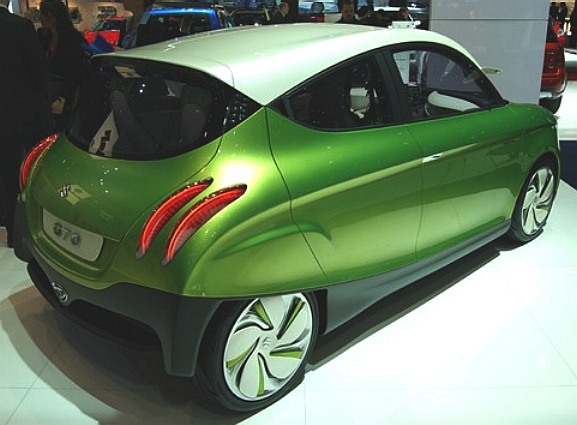
Geneva motor show, Suzuki eco G70 concept car
Historical Timeline
1910 - Suzuki Loom Works founded in Hamamatsu, Shizuoka Prefecture, by Michio Suzuki.
1920 - Reorganized, incorporated, and capitalized at 500,000 yen as Suzuki Loom Manufacturing Co. with Michio Suzuki as president.
1952 - 'Power Free' motorized bicycle marketed.
1954 - Company name changed to Suzuki Motor Co.,Ltd.
1955 - Lightweight car 'Suzulight' (360cc, 2-stroke) marketed helping to usher in Japan's light-weight car age.
1961 - Suzuki Loom Manufacturing Co. established by separating the loom machine division from the motor works and lightweight truck 'Suzulight Carry' marketed.
1962 - Suzuki won the 50cc class championship at the Isle of Man (U.K.)
1963 - U.S. Suzuki Motor Corp., a direct sales subsidiary, opened in Los
Angeles.
1965 - 'D55' (5.5hp, 2-stroke) outboard motor marketed and makes early inroads and Fronte 800 marketed.
1967 - Thai Suzuki Motor Co., Ltd. established as a local assembly plant.
1968 - Carry full-cab van marketed.
1970 - LJ-Series 4X4 marketed.
1971 - GT750 motorcycle marketed.
1973 - Suzuki Canada Ltd., opened in Ontario, Canada.
1974 - P.T. Suzuki Indonesia Manufacturing established in Jakarta, Indonesia, entry into medical equipment field by marketing the Suzuki Motor Chair Z600 motorized wheelchair, expansion into the housing field initiated with Suzuki Home marketing two models of prefab 'Mini-House' and three types of storage sheds.
1975 - Antonio Suzuki Corp., a joint venture for knockdown production and sales, established in Manila, the
Philippines.
1976 - GS-Series motorcycles marketed.
1977 - LJ80 4x4 vehicle marketed and exports of GS1000H motorcycle began.
1979 - Alto marketed.
1979 - SC100 marketed in the UK.
1980 - Suzuki Australia Pty. Ltd. established in Sydney, Australia and entry into general purpose engine field by marketing three electric power generator models.
1981 - Business ties with General Motors (U.S.) and Isuzu Motors, Ltd.(Japan) signed.
1982 - 4X4 production began at PAK Suzuki Motor Co., Ltd. in Karachi, Pakistan and won maker championship for 7th consecutive year at the World Road Race Grand Prix 500.
1982 - SC100 Discontinued in favour of Alto.
1983 - Cultus/Swift 1.0-liter passenger car marketed and 4X4 production started at Maruti Udyog Ltd. in New Delhi, India.
1984 - Suzuki New Zealand Ltd. established in Wanganui, New Zealand and began export of Chevrolet Sprint to the United States. Car production technical assistance contract signed with China National Aerotechnology Import & Export Beijing Corporation. Operation of Suzuki Motor GmbH Deutschland began in
Heppenheim, Germany.
1985 - SUZUKI of AMERICA AUTOMOTIVE CORP. established with the introduction of the Samurai, and the sensational GSX-R750 motorcycle with an oil-cooled engine marketed and scooter production started at Avello S.A. of Spain. Agreement with Santana Motors to produce Suzuki cars in their Linares factory in Andalusia, Spain.
1986 - American Suzuki Motor Corp. is formed merging U.S. Suzuki Motor Corp and Suzuki of America Automotive Corp.
1987 - Cultus/Swift production began in Colombia and total aggregate car exports reached 2 million units.
1988 - Escudo/Vitara 4x4 marketed and total aggregate car production reached 10 million
units.
1989 - CAMI Automotive Inc. established and began operation in Ontario, Canada. Swift GT/GLX and Sidekick sales begin in the United States.
1990 - Corporate name changed to Suzuki Motor Corporation.
1991 - Car production started in Korea through technical ties with Daewoo Shipbuilding & Heavy Machinery Ltd and Cappuccino 2-seater marketed.
The Suzuki plant in Esztergom, Hungary has over 6000 employees. (As of 2007)1993 - Passenger car production/sales began at Suzuki Egypt S.A.E., opening ceremony for new car production plant held at Magyar Suzuki Corp. in Esztergom, Hungary and Wagon R passenger car marketed.
1994 - Maruti Udyog Ltd. of India total aggregate car production reached 1 million units.
1995 - Total aggregate motorcycle export reached 20 million units
1996 - Start of production in Vietnam (Motorcycles and automobiles)
1997 - Achieved 10 million cumulative automobile sales for overseas market and 4-stroke outboard motors win the Innovation Award at The International Marine Trade Exhibit and Conference (IMTEC) in Chicago.
1998 - Suzuki and General Motors form strategic alliance and Chongqing Chang'an Suzuki Automobile Co., Ltd. received official approval from the Chinese government for production of passenger cars.
1999 - Aggregate motorcycle production reaches 40 million units and Jiangxi Changhe Suzuki Automobile Co., Ltd. receives official approval from the Chinese government for production of commercial vehicles.
2000 - The company commemorates the 80th anniversary, aggregate car production at Kosai Plant reaches 10 million units and Suzuki production starts at General Motors de Argentina S.A.
2001 - Aggregate worldwide sales of SJ-Series reaches 2 million units, production of Alto reaches 4 million units and Suzuki achieves "Zero-Level" target of landfill waste
2002 - Achieved 30 million cumulative automobile sales for worldwide market and America's #1 warranty: 100,000/7-year powertrain limited warranty.
2003 - Suzuki is #1 in Keicar sales for the 30th consecutive year and Twin, the first hybrid Keicar in Japan, marketed.
2004 - Aggregate domestic automobile sales reach 15 million units
2005 - Swift was awarded the 2006 RJC Car of the Year.
2006 - New XL7 is marketed particularly to the North American market and GM divested, selling 92.36 million shares and reducing their stake to 3%.
2008 - Suzuki introduces its first production fuel-injected motocross bike.
2012
- Suzuki Swift (Third Generation), a new age of eco-car, is started the
production on March 2012 in a new factory based in Rayong province,
Thailand which Suzuki invested 20 billion yen in 2009 targeting its
compact car production
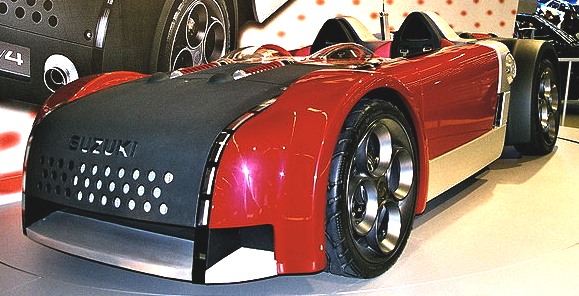
Suzuki
concept car 2002
Maruti Suzuki
Maruti Driving School in Tamil Nadu.Based in Gurgaon, India, Maruti Suzuki India Limited is Suzuki's largest and most valuable subsidiary with an annual production of 626,071 units in 2006.[1] Suzuki has a 54.2% stake in the Indian auto giant and the rest is owned by the various Indian public and financial institutions. The company was incorporated in 1981 and is listed on the Bombay Stock Exchange and National Stock Exchange of India.[2] In 2005-2006, the company had a 54% market share of the passenger car market in India.[3] Nearly 75,000 people are employed directly by Maruti and its partners.
Maruti Suzuki was born as a Government of India company, with Suzuki as a minor partner, to make a people’s car for middle class India. Over the years, the product range has widened, ownership has changed hands and the customer has evolved.
Maruti Suzuki offers 10 models, ranging from India's best selling car, Maruti 800, for less than INR 200,000 (US$ 5000) to the premium sedan Maruti SX4 and luxury
SUV, Maruti Grand Vitara. Maruti 800 was the first model launched by the company in 1983 followed by mini-van Maruti Omni in 1984. Both models were huge success in their respective categories because of the use of high-end technology and good fuel efficiency. Maruti Gypsy, launched in 1985, came into widespread use with the Indian Army and Indian Police Service becoming its primary customers. The short-lived Maruti 1000 too achieved moderate success until it was replaced by Maruti Esteem in 1994, to counter increasing competition in the medium-sedan category.
Maruti Zen, launched in 1993, was the company's second compact car model and also became extremely popular in India because of its high performance. The company went on to launch another compact car Maruti Wagon-R followed by Maruti Baleno in 1999. However, with increasing competition from
Tata, Hyundai, Honda and Daewoo Motors, Maruti was not able to achieve the same success with Wagon-R and Baleno as it had with its earlier models.
In 2000, Maruti Alto was launched. The launch of Tata Indica and Hyundai Santro had affected Maruti's sales but Alto helped secure the company's position as the auto leader in India. It is currently the largest selling car in India. The Maruti models include Maruti Suzuki Grand Vitara, launched in 2003, Maruti Versa, launched in 2004, Maruti Suzuki Swift, launched in 2005, Maruti Zen Estilo and Maruti Suzuki SX4, launched in 2007. The company is expected to launch Maruti Suzuki Liana sedan in January 2008.
Maruti Exports Limited is the subsidiary of Maruti Udyog Limited with its major focus on exports and it does not operate in the domestic Indian market. The first commercial consignment of 480 cars were sent to Hungary. By sending a consignment of 571 cars to the same country Maruti crossed the benchmark of 3,00,000 cars. Since its inception export was one of the aspects government was keen to encourage. Every political party expected Maruti to earn foreign currency.
Angola, Benin, Djibouti, Ethiopia, Europe, Kenya, Morocco, Sri Lanka, Uganda, Chile, Guatemala, Costa Rica and El Salvador are some of the markets served by Maruti Exports.
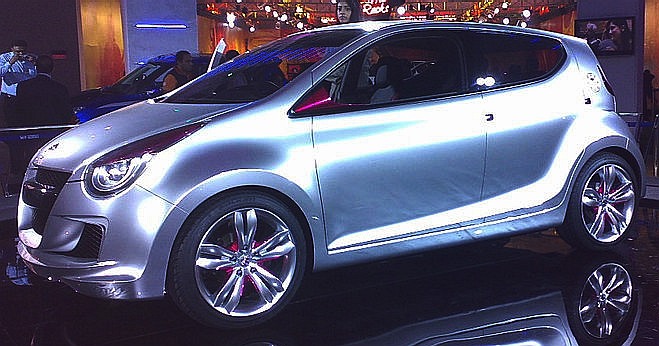
American Suzuki Motor Corp History
American Suzuki headquarters is located in Brea, California. Through an agreement with General Motors, Suzuki began selling a version of their Suzuki Cultus in United States as the Chevrolet Sprint in 1985. This model was initially sold as a 3-door hatchback and would be Chevrolet's smallest model.
2004 Suzuki 7-XLThe Samurai was also introduced in 1985 for the 1986 model year and was the first car introduced to the United States by the newly created American Suzuki Corp. No other Japanese company sold more cars in the United States in its first year than Suzuki. The Samurai was available as a convertible or hardtop and the company slogan was Never a Dull Moment. The Samurai was successful until Consumer Reports noticed that the Samurai was susceptible to roll over in a 1988 test.
In 1989, American Suzuki introduced the Swift which was the 2nd generation Suzuki Cultus. The Swift was available as a GTi and GLX hatchback with a 4-door sedan following in 1990. A new small SUV called the Sidekick was also introduced in 1989. 1991 saw the introduction of the 4-door Suzuki Sidekick, the first 4-door mini-SUV in North America. The Swift and Sidekick were cousins to GM's Geo Metro and Geo Tracker and were mostly produced in Ingersoll, Canada by Suzuki and GM's joint venture, CAMI. The Swift GT/GTi and 4-door models were imported from japan. Bad publicity from Consumer Reports of the Suzuki Samurai led to some temporary setbacks at American Suzuki as annual sales in the following years dropped to below 20,000 units.
In 1995, American Suzuki introduced the Esteem and redesigned the Swift. The Swift GT was dropped and this version Swift was specific only to North America where it was built at CAMI. These models were the first Suzuki vehicles to be marketed in North America with dual front airbags. A stationwagon version of the Esteem was introduced in 1996. Worldwide Suzuki production reached more than 975,000 cars this year.
Also in 1996, American Suzuki released the 2-door SUV X-90 and a revised Sidekick Sport model with dual airbags, a 120hp 1.8-liter engine, 16" wheels and two-tone paint. The Sidekick was replaced by the Vitara and the Grand Vitara for 1999. The Grand Vitara would be Suzuki's first model with a V6-cylinder engine and available 4-wheel ABS brakes.
The Grand Vitara XL-7 was introduced in 2001 as a stretched version of the Grand Vitara. The Grand Vitara XL-7 had a larger 2.7 liter V6-cylinder engine and 3-row seating. This would be Suzuki's largest vehicle to date and the first compact SUV to offer 3-row seating.
The Swift was dropped from the model lineup in 2001 and the Esteem was replaced in 2002 by the new Aerio. The Aerio was offered as a 4-door sedan and 5-door crossover with 4-wheel-drive as an option.
In 2004, General Motors and Suzuki jointly purchased the bankrupt Daewoo Motors renaming the venture GMDAT. American Suzuki rebadged the compact Daewoo Nubira/Daewoo Lacetti as the Forenza and the mid-size Daewoo Magnus as the Verona. The Forenza gained stationwagon and hatchback body style in 2005, with the hatchback sold under the Reno name.
2006 was the first year American Suzuki sold more than 100,000 vehicles in the United States. Suzuki redesigned the Grand Vitara in 2006 as well as introduced the all-new Suzuki SX4 and Suzuki XL7 in 2007. The Suzuki SX4 is produced as a joint venture with Fiat S.p.A. and the Suzuki XL7 (notice the shortening of the name from Grand Vitara XL-7) is produced as a joint venture with GM at CAMI Automotive Inc. in Ingersoll, Ontario, Canada.
Pak Suzuki Motor Company Limited
In pursuance of the terms and conditions of the Joint Venture Agreement executed between Suzuki Motor Corporation of Japan (SMC) and Pakistan Automobile Corporation
(PACO), Pak Suzuki Motor Company Limited (PSMCL) was incorporated as a public limited company in August 1983.
The new company took over the assets which included production facilities of Awami Autos Limited. PSMCL started commercial operations in January 1984 with the primary objective of passenger cars, pick ups, vans and 4x4 vehicles.
The foundation stone laying ceremony of the company’s green field automobile plant at Bin Qasim was performed by the then prime Minister of Pakistan in early 1989.
On completion of first phase of this plant in early 1990,in- house assembly of all types of Suzuki engines started. The new plant was completed in 1992, on its completion all Suzuki products were transferred to new plant and three box 1300cc Margalla car was also added to its range of production.
In September 1992 the company was privatized and placed directly under the Japanese Management. At the time of privatization SMC increased its equity from 25% to 40% Subsequently, SMC progressively increased its equity to 73.09% by December 31,2001.
The Bin Qasim Plant further expanded its production capacity to 50,000 vehicles per year in July 1994 and 3,00,000 vehicles had been manufactured at this plant by December 2003.
The most modern automobile manufacturing plant in the country distinguishes Pak Suzuki from other automobile plants.
Suzuki
Maruti MPV launch - Youtube
Suzuki Canada Inc. History
1973 - June 1, Suzuki Canada Ltd. was incorporated with offices at Downsview, Ontario. Product lines included motorcycles, parts and accessories to Suzuki dealers throughout Canada.
1974 - Vancouver branch office and warehouse inaugurated to service dealers in western Canada.
1980 - Autumn - Suzuki Canada began its automotive sales with the marketing and sales of four-wheel-LJ80 in eastern Canada. November 1, the name of company changed from Suzuki Canada Ltd. to Suzuki Canada Inc.
1982 - Introduction of a line of Suzuki all-terrain vehicles (ATVs) in Canada.
1983 - Introduction of a line of Suzuki outboard motors in western Canada. February 1, 1983 - Western Branch moved to enlarged facilities in Richmond, British Columbia.
1984 - Began the sales of 'Suzuki Forsa' (Suzuki Cultus) automobile.
1986 - A $600 million Suzuki-GM joint venture CAMI Automotive Inc. announced for the manufacturing of vehicles. Production was set to begin in 1989 at Ingersoll, Ontario.
1987 - January 25 - Suzuki Canada Inc. moved to a new 110,000 sq. ft. head office and warehouse facility at Richmond Hill, Ontario.
1988 - Autumn - Suzuki began selling the CAMI-built 2-door Suzuki Sidekick.
OEM deals
Beginning in 1985, Suzuki has built cars for or been the basis of other manufacturers around the globe.
General Motors - The Suzuki Cultus/Suzuki Swift was rebadged as the Chevrolet Sprint and in Canada, also the Pontiac Firefly and the Geo Metro, along with a (GM) Holden Barina in Australia. The Suzuki Ignis was rebadged as the Chevrolet Cruze and Holden Cruze in Japan and Australia. The Suzuki Carry was rebadged as the Bedford Rascal and Vauxhall Rascal in the United Kingdom, Holden Scurry in Australia and Chevrolet Supercarry in Ecuador. The Suzuki Sidekick was rebadged as the Geo Tracker, Chevrolet Tracker, and Pontiac Sun Runner. The Suzuki Vitara was rebadged as the Geo Tracker and Chevrolet Tracker. The Suzuki XL-7 was rebadged in South America as the Chevrolet Grand Nomad. The Suzuki SJ-Series was rebadged as the Holden Drover.
Subaru - In Europe, the second generation Suzuki Swift and the Suzuki Ignis were rebadged as the Subaru Justy.
Mazda - Most of Mazda's Autozam keicar models are rebadged Suzuki products. The Suzuki Vitara was also sold as the Mazda Proceed.
Nissan - Nissan Moco is a rebadged Suzuki MR Wagon. Suzuki has recently collaborated further with Nissan, as the latter will supply Suzuki with a mid-sized pickup while the former will provide Nissan with additional minicars for the Japanese home market.
Maruti Udyog - Suzuki and India jointly own this company with all models being rebadged Suzuki.
www.marutiudyog.com
Chang'an Automotive Corp www.changansuzuki.com
- Suzuki Swift, Suzuki Alto, Suzuki Carry
Jiangxi Changhe www.changhe-suzuki.com
Automobiles
Aerio/Liana
Alto
A-Star
Alto Lapin
APV
Cappuccino
Carry
Cervo
Escudo
Esteem/Cultus Crescent
Fronte
Grand Vitara
Ignis
Jimny
LJ-Series
MightyBoy
MR Wagon
SJ-Series
Swift/Cultus
SX4
Suzuki Twin
Wagon R
X-90
XL7
Models sold as Mazda's Autozam
Cara
Daewoo based North American models
Swift+
Forenza/Reno
Verona
Chevrolet based South American models
Fun
Maruti
Suzuki Eeco Electric-Aaj Tak - Youtube
Motorcycles
2002 Suzuki FXR150Suzuki started manufacturing motorcycles in 1952, the first models being motorized bicycles. During the 1950s, 1960s and the better part of the 1970s, the company manufactured motorcycles with two-stroke engines only, the biggest two-stroke model being the water-cooled triple-cylinder GT750.
A large factor in Suzuki's success in two-stroke competition was the East German Grand Prix racer Ernst Degner, who defected to the West in 1961, bringing with him expertise in two-stroke engines from the East German manufacturer MZ. Suzuki hired Degner, and he won the 50cc F.I.M. road racing World Championship for them in 1962. Suzuki became the first Japanese manufacturer to win a motocross world championship when Joel Robert won the 1970 250cc title. In the 1970s, Suzuki established themselves in the motorcycle racing world with Barry Sheene and Roger De Coster winning world championships in the premier 500cc division in road racing and motocross respectively.
However, it wasn't until 1976 that Suzuki introduced its first motorcycle with a four-stroke engine, the GS400 and GS750. Since then, Suzuki has established a reputation as a manufacturer of well-engineered sport motorcycles.
In 1994, Suzuki partnered with Nanjing Jincheng Machinery to create a Chinese motorcycle manufacturer and exporter called Jincheng Suzuki.
Models
All-terrain vehicles (ATVs)
A 2004 Suzuki LT-Z400 with some common and custom modifications doneQuadrunner
Suzuki KingQuad 700
Suzuki TwinPeaks 700
Suzuki Vinson 500
Suzuki Eiger 400
Suzuki Ozark 250
Quadsport
Suzuki LT 230
Suzuki LT 250
Suzuki LT-Z250
Suzuki LT-Z400
Suzuki LT-R450 (race ready)
Suzuki Escudo Pikes Peak version (rally/road)
Suzuki Cultus Pikes Peak version (rally/road)
SUZUKI
MOTORCYCLES
Undeniably
styled on the 'V' twin Harley Davidson, this beautifully finished Japanese
machine was great fun to cruise down to the village shops for the daily
newspaper. No slouch either, 750cc pulling power could make those
little errands quite exciting.
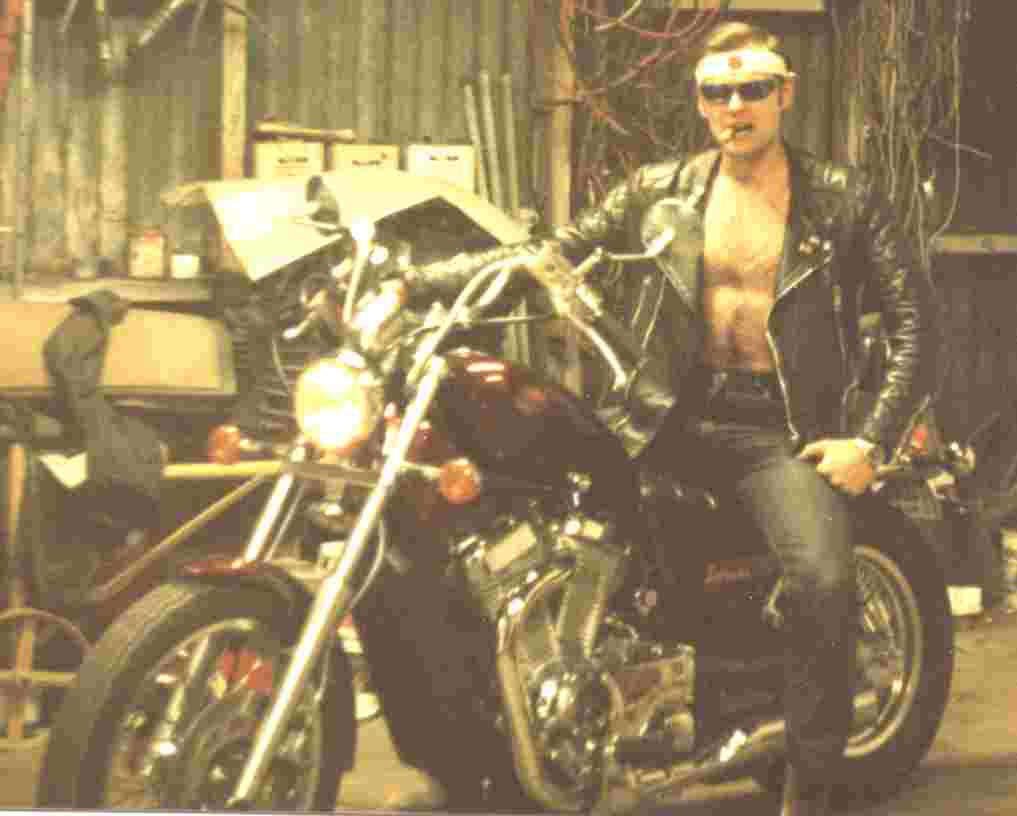
Suzuki Intruder
This
uncomplicated machine (a little heavy) took the roughest terrain in its
stride. Nelson bought this bike from Eric Kennard in Seaford as a
write-off. It's first owner had ridden it down hill into a tree and
buckled the forks and front wheel after 100 miles. It was repaired
and regularly used for off-road fun and other summer outings. Nelson
sold this machine three times each time buying it back for another years
use, before eventually saying goodbye. Fond memories.
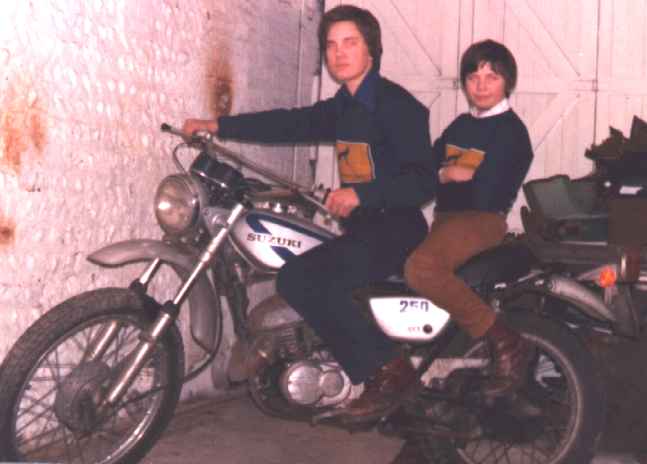
Suzuki TS 250
LINKS
and REFERENCE
|
Visit
esure.com
for cheaper
car and bike insurance |
If
you purchase your insurance via a dedicated link from this site, you
could not only save money, but you'll also be helping us provide free
information to thousands of students - at no cost to you. Please help
if you can and thanks for considering us.

Please
click on the links above to find out about these famous automotive
makers. If your company is not included and you would like to be
listed, please let us know.
UK
VEHICLE INSURANCE ONLINE A - Z
No
matter what car, van or bike you drive, we're all looking for great
value and quality in our UK motor insurance? But who is the best
- who is the cheapest and who offers the great service in the event of
a claim?
See
the insurance companies below who claim to offer competitive cover at
sensible prices, our
guide to the jargon and tips for cutting your quote - Good
Luck:-
Automotive
Prehistory Links
CONTACTS
A
taste for adventure
capitalists

The
world's fastest electric car: 350mph + using energy from nature
and
battery or fuel cell cartridge exchange
|







